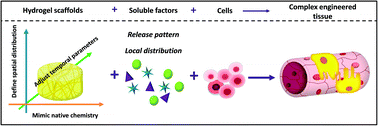Biomimetic hydrogels with spatial- and temporal-controlled chemical cues for tissue engineering
Abstract
Biomimetic hydrogels have emerged as the most useful tissue engineering scaffold materials. Their versatile chemistry can recapitulate multiple physical and chemical features to integrate cells, scaffolds, and signaling molecules for tissue regeneration. Due to their highly hydrophilic nature hydrogels can recreate nutrient-rich aqueous environments for cells. Soluble regulatory molecules can be incorporated to guide cell proliferation and differentiation. Importantly, the controlled dynamic parameters and spatial distribution of chemical cues in hydrogel scaffolds are critical for cell–cell communication, cell-scaffold interaction, and morphogenesis. Herein, we review biomimetic hydrogels that provide cells with spatiotemporally controlled chemical cues as tissue engineering scaffolds. Specifically, hydrogels with temporally controlled growth factor-release abilities, spatially controlled conjugated bioactive molecules/motifs, and targeting delivery and reload properties for tissue engineering applications are discussed in detail. Examples of hydrogels that possess clinically favorable properties, such as injectability, self-healing ability, stimulus-responsiveness, and pro-remodeling features, are also covered.

- This article is part of the themed collection: Biomimetic Therapeutics


 Please wait while we load your content...
Please wait while we load your content...